Innovation and Sustainable Business Development Analysis Report
VerifiedAdded on 2020/03/01
|8
|2034
|94
Report
AI Summary
This report provides a comprehensive analysis of business model innovation and its relationship with sustainable business development. It begins by defining the business model and emphasizing its importance in a competitive environment, discussing how companies generate revenue and increase profitability. The report then explores various business model archetypes, including product, service, and trade, along with secondary archetypes like brokerage and subscription, and their relevance to business strategy. The concept of the business model as an activity system, with interconnected decisions and value chains, is also examined. Furthermore, the report delves into cost-revenue architecture, highlighting its role in fostering growth and bridging gaps between growth aspirations and revenue execution. It also provides a detailed understanding of the business context and the need for change within the business environment, emphasizing the impact of external factors and the importance of adapting to changing circumstances. Finally, the report differentiates between static and dynamic business models, concluding that business model innovation is crucial for success in the volatile and competitive business landscape.
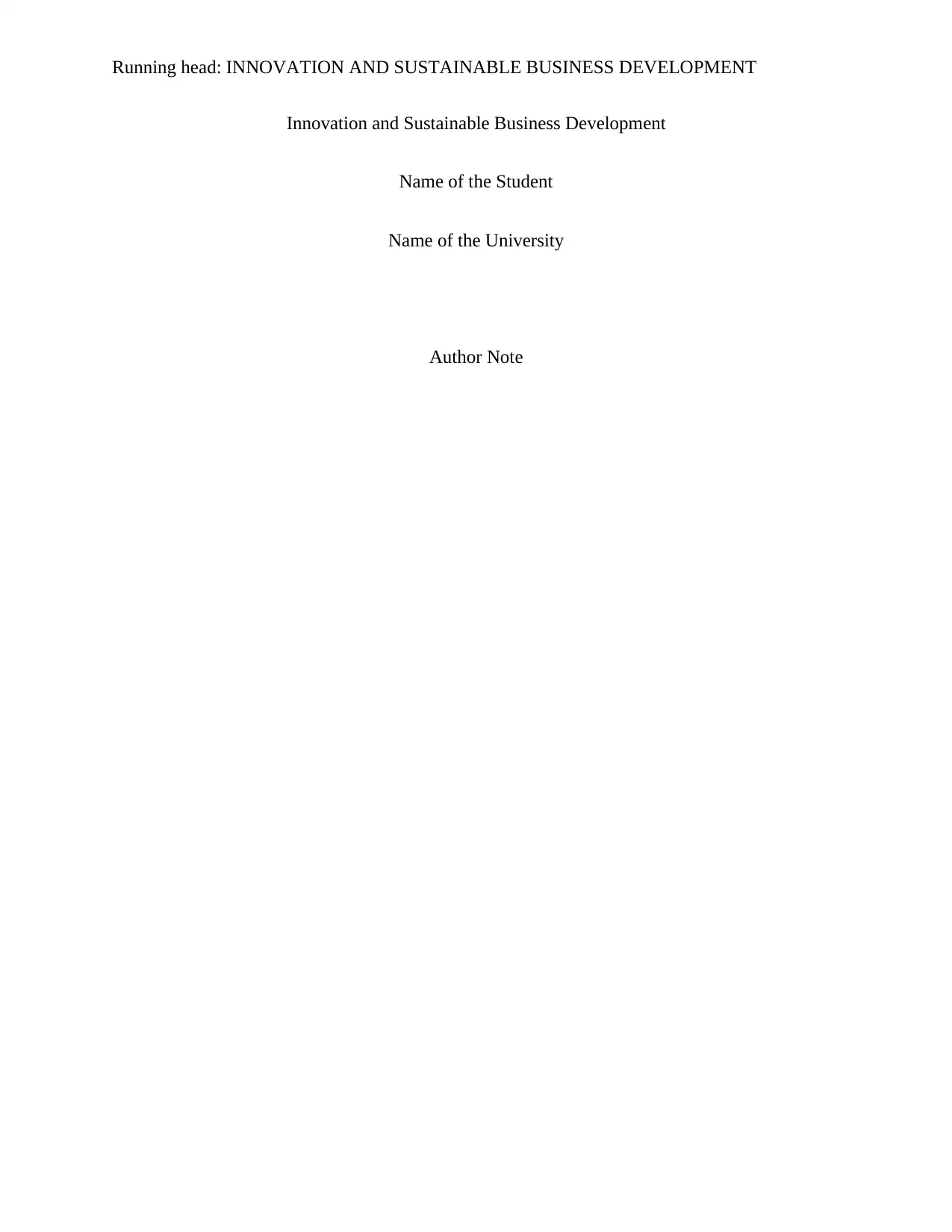
Running head: INNOVATION AND SUSTAINABLE BUSINESS DEVELOPMENT
Innovation and Sustainable Business Development
Name of the Student
Name of the University
Author Note
Innovation and Sustainable Business Development
Name of the Student
Name of the University
Author Note
Paraphrase This Document
Need a fresh take? Get an instant paraphrase of this document with our AI Paraphraser
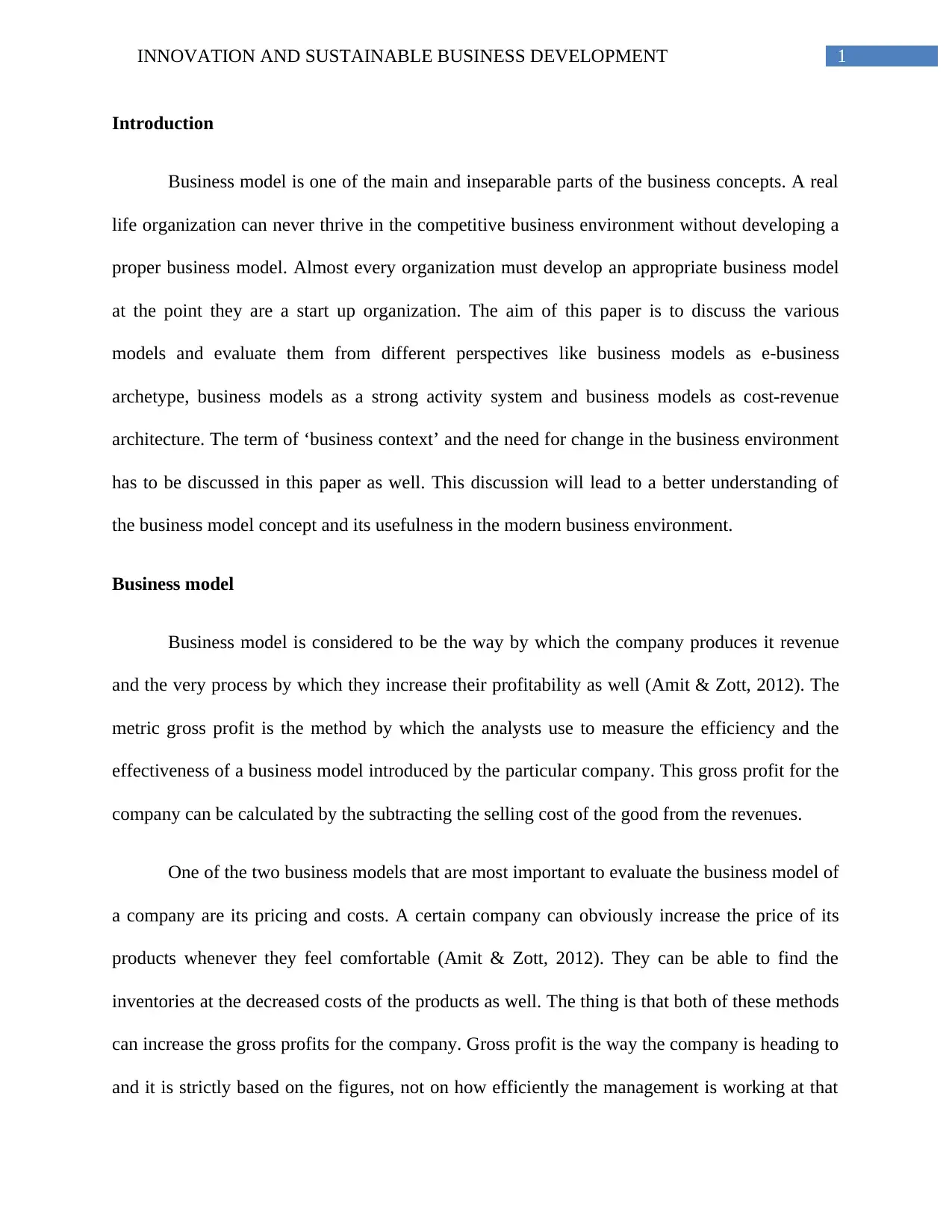
1INNOVATION AND SUSTAINABLE BUSINESS DEVELOPMENT
Introduction
Business model is one of the main and inseparable parts of the business concepts. A real
life organization can never thrive in the competitive business environment without developing a
proper business model. Almost every organization must develop an appropriate business model
at the point they are a start up organization. The aim of this paper is to discuss the various
models and evaluate them from different perspectives like business models as e-business
archetype, business models as a strong activity system and business models as cost-revenue
architecture. The term of ‘business context’ and the need for change in the business environment
has to be discussed in this paper as well. This discussion will lead to a better understanding of
the business model concept and its usefulness in the modern business environment.
Business model
Business model is considered to be the way by which the company produces it revenue
and the very process by which they increase their profitability as well (Amit & Zott, 2012). The
metric gross profit is the method by which the analysts use to measure the efficiency and the
effectiveness of a business model introduced by the particular company. This gross profit for the
company can be calculated by the subtracting the selling cost of the good from the revenues.
One of the two business models that are most important to evaluate the business model of
a company are its pricing and costs. A certain company can obviously increase the price of its
products whenever they feel comfortable (Amit & Zott, 2012). They can be able to find the
inventories at the decreased costs of the products as well. The thing is that both of these methods
can increase the gross profits for the company. Gross profit is the way the company is heading to
and it is strictly based on the figures, not on how efficiently the management is working at that
Introduction
Business model is one of the main and inseparable parts of the business concepts. A real
life organization can never thrive in the competitive business environment without developing a
proper business model. Almost every organization must develop an appropriate business model
at the point they are a start up organization. The aim of this paper is to discuss the various
models and evaluate them from different perspectives like business models as e-business
archetype, business models as a strong activity system and business models as cost-revenue
architecture. The term of ‘business context’ and the need for change in the business environment
has to be discussed in this paper as well. This discussion will lead to a better understanding of
the business model concept and its usefulness in the modern business environment.
Business model
Business model is considered to be the way by which the company produces it revenue
and the very process by which they increase their profitability as well (Amit & Zott, 2012). The
metric gross profit is the method by which the analysts use to measure the efficiency and the
effectiveness of a business model introduced by the particular company. This gross profit for the
company can be calculated by the subtracting the selling cost of the good from the revenues.
One of the two business models that are most important to evaluate the business model of
a company are its pricing and costs. A certain company can obviously increase the price of its
products whenever they feel comfortable (Amit & Zott, 2012). They can be able to find the
inventories at the decreased costs of the products as well. The thing is that both of these methods
can increase the gross profits for the company. Gross profit is the way the company is heading to
and it is strictly based on the figures, not on how efficiently the management is working at that
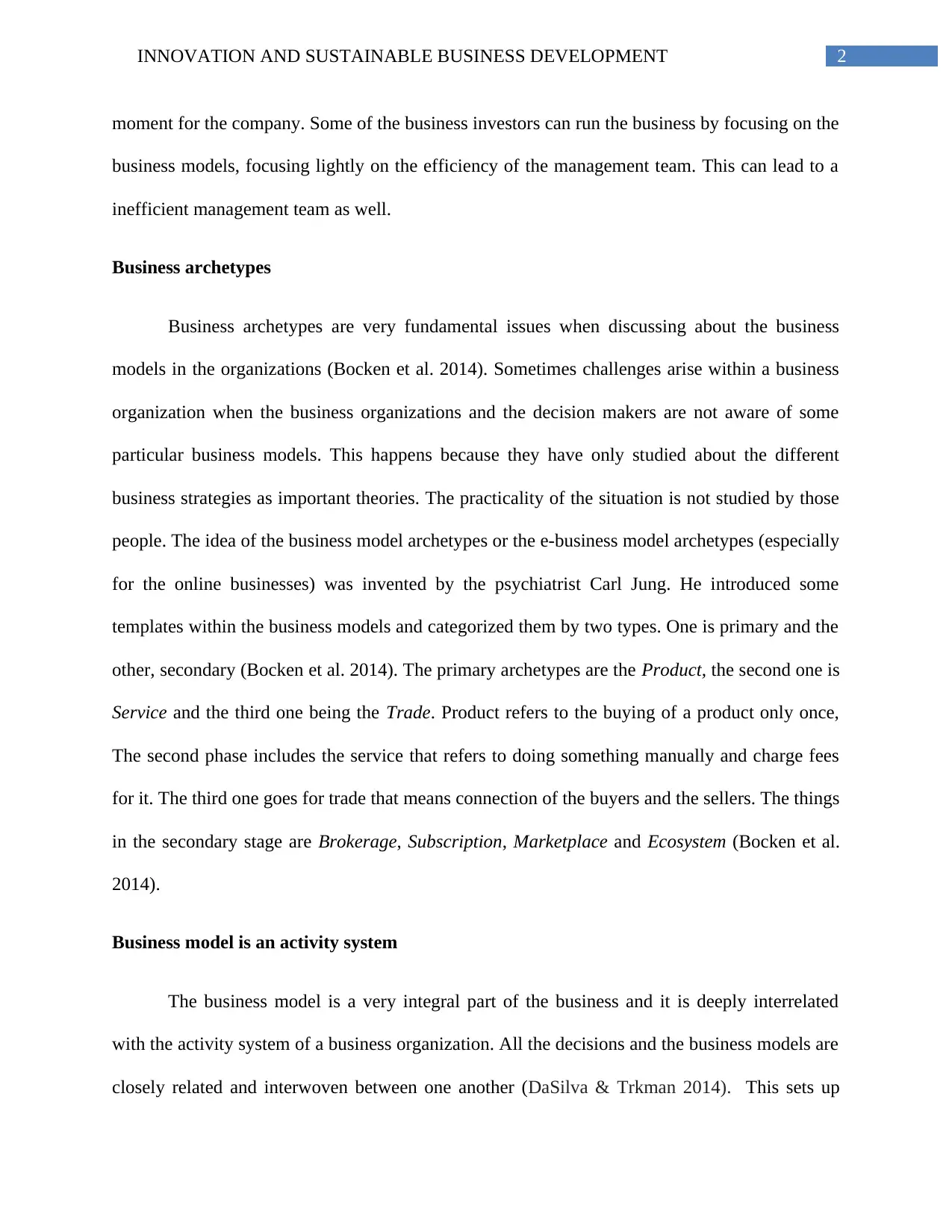
2INNOVATION AND SUSTAINABLE BUSINESS DEVELOPMENT
moment for the company. Some of the business investors can run the business by focusing on the
business models, focusing lightly on the efficiency of the management team. This can lead to a
inefficient management team as well.
Business archetypes
Business archetypes are very fundamental issues when discussing about the business
models in the organizations (Bocken et al. 2014). Sometimes challenges arise within a business
organization when the business organizations and the decision makers are not aware of some
particular business models. This happens because they have only studied about the different
business strategies as important theories. The practicality of the situation is not studied by those
people. The idea of the business model archetypes or the e-business model archetypes (especially
for the online businesses) was invented by the psychiatrist Carl Jung. He introduced some
templates within the business models and categorized them by two types. One is primary and the
other, secondary (Bocken et al. 2014). The primary archetypes are the Product, the second one is
Service and the third one being the Trade. Product refers to the buying of a product only once,
The second phase includes the service that refers to doing something manually and charge fees
for it. The third one goes for trade that means connection of the buyers and the sellers. The things
in the secondary stage are Brokerage, Subscription, Marketplace and Ecosystem (Bocken et al.
2014).
Business model is an activity system
The business model is a very integral part of the business and it is deeply interrelated
with the activity system of a business organization. All the decisions and the business models are
closely related and interwoven between one another (DaSilva & Trkman 2014). This sets up
moment for the company. Some of the business investors can run the business by focusing on the
business models, focusing lightly on the efficiency of the management team. This can lead to a
inefficient management team as well.
Business archetypes
Business archetypes are very fundamental issues when discussing about the business
models in the organizations (Bocken et al. 2014). Sometimes challenges arise within a business
organization when the business organizations and the decision makers are not aware of some
particular business models. This happens because they have only studied about the different
business strategies as important theories. The practicality of the situation is not studied by those
people. The idea of the business model archetypes or the e-business model archetypes (especially
for the online businesses) was invented by the psychiatrist Carl Jung. He introduced some
templates within the business models and categorized them by two types. One is primary and the
other, secondary (Bocken et al. 2014). The primary archetypes are the Product, the second one is
Service and the third one being the Trade. Product refers to the buying of a product only once,
The second phase includes the service that refers to doing something manually and charge fees
for it. The third one goes for trade that means connection of the buyers and the sellers. The things
in the secondary stage are Brokerage, Subscription, Marketplace and Ecosystem (Bocken et al.
2014).
Business model is an activity system
The business model is a very integral part of the business and it is deeply interrelated
with the activity system of a business organization. All the decisions and the business models are
closely related and interwoven between one another (DaSilva & Trkman 2014). This sets up
⊘ This is a preview!⊘
Do you want full access?
Subscribe today to unlock all pages.

Trusted by 1+ million students worldwide
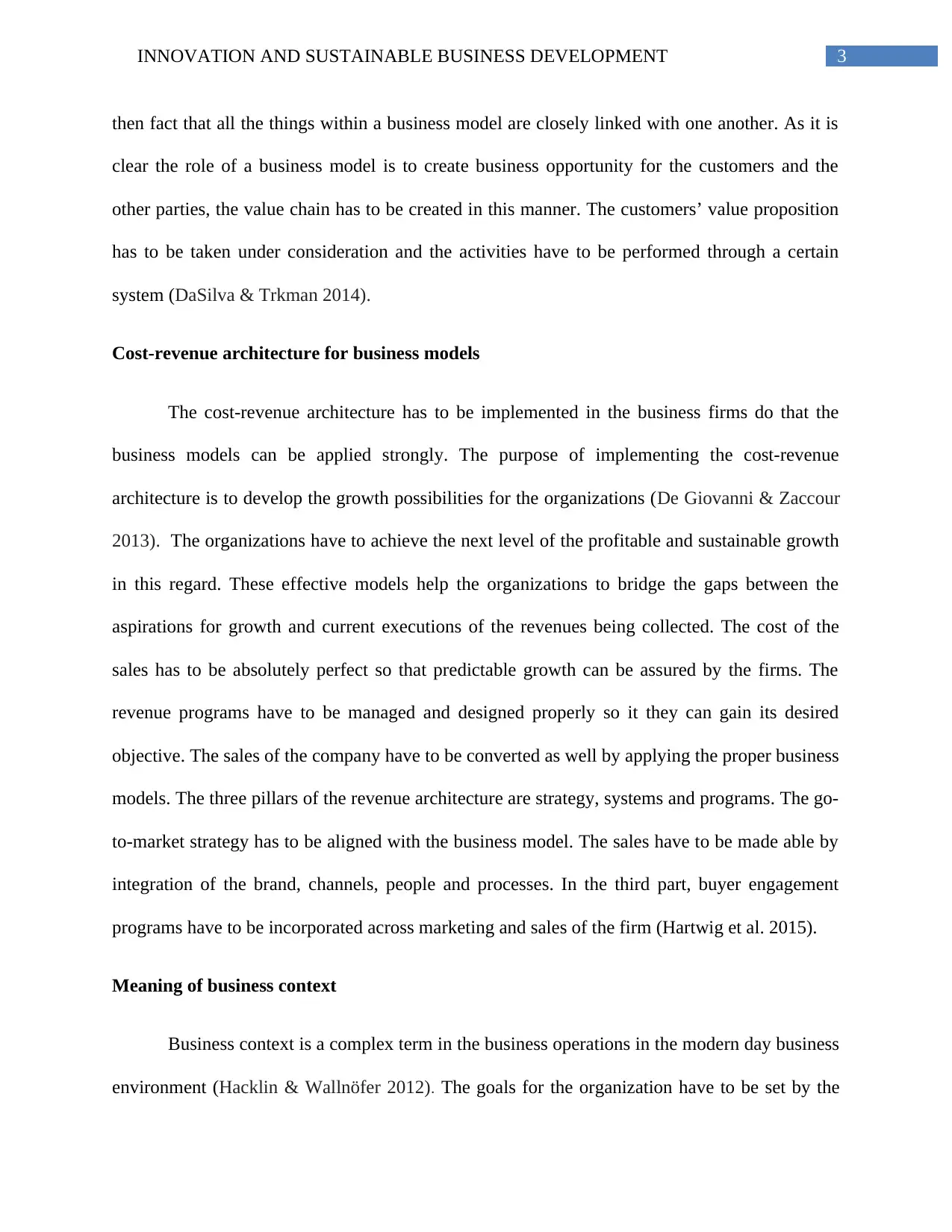
3INNOVATION AND SUSTAINABLE BUSINESS DEVELOPMENT
then fact that all the things within a business model are closely linked with one another. As it is
clear the role of a business model is to create business opportunity for the customers and the
other parties, the value chain has to be created in this manner. The customers’ value proposition
has to be taken under consideration and the activities have to be performed through a certain
system (DaSilva & Trkman 2014).
Cost-revenue architecture for business models
The cost-revenue architecture has to be implemented in the business firms do that the
business models can be applied strongly. The purpose of implementing the cost-revenue
architecture is to develop the growth possibilities for the organizations (De Giovanni & Zaccour
2013). The organizations have to achieve the next level of the profitable and sustainable growth
in this regard. These effective models help the organizations to bridge the gaps between the
aspirations for growth and current executions of the revenues being collected. The cost of the
sales has to be absolutely perfect so that predictable growth can be assured by the firms. The
revenue programs have to be managed and designed properly so it they can gain its desired
objective. The sales of the company have to be converted as well by applying the proper business
models. The three pillars of the revenue architecture are strategy, systems and programs. The go-
to-market strategy has to be aligned with the business model. The sales have to be made able by
integration of the brand, channels, people and processes. In the third part, buyer engagement
programs have to be incorporated across marketing and sales of the firm (Hartwig et al. 2015).
Meaning of business context
Business context is a complex term in the business operations in the modern day business
environment (Hacklin & Wallnöfer 2012). The goals for the organization have to be set by the
then fact that all the things within a business model are closely linked with one another. As it is
clear the role of a business model is to create business opportunity for the customers and the
other parties, the value chain has to be created in this manner. The customers’ value proposition
has to be taken under consideration and the activities have to be performed through a certain
system (DaSilva & Trkman 2014).
Cost-revenue architecture for business models
The cost-revenue architecture has to be implemented in the business firms do that the
business models can be applied strongly. The purpose of implementing the cost-revenue
architecture is to develop the growth possibilities for the organizations (De Giovanni & Zaccour
2013). The organizations have to achieve the next level of the profitable and sustainable growth
in this regard. These effective models help the organizations to bridge the gaps between the
aspirations for growth and current executions of the revenues being collected. The cost of the
sales has to be absolutely perfect so that predictable growth can be assured by the firms. The
revenue programs have to be managed and designed properly so it they can gain its desired
objective. The sales of the company have to be converted as well by applying the proper business
models. The three pillars of the revenue architecture are strategy, systems and programs. The go-
to-market strategy has to be aligned with the business model. The sales have to be made able by
integration of the brand, channels, people and processes. In the third part, buyer engagement
programs have to be incorporated across marketing and sales of the firm (Hartwig et al. 2015).
Meaning of business context
Business context is a complex term in the business operations in the modern day business
environment (Hacklin & Wallnöfer 2012). The goals for the organization have to be set by the
Paraphrase This Document
Need a fresh take? Get an instant paraphrase of this document with our AI Paraphraser
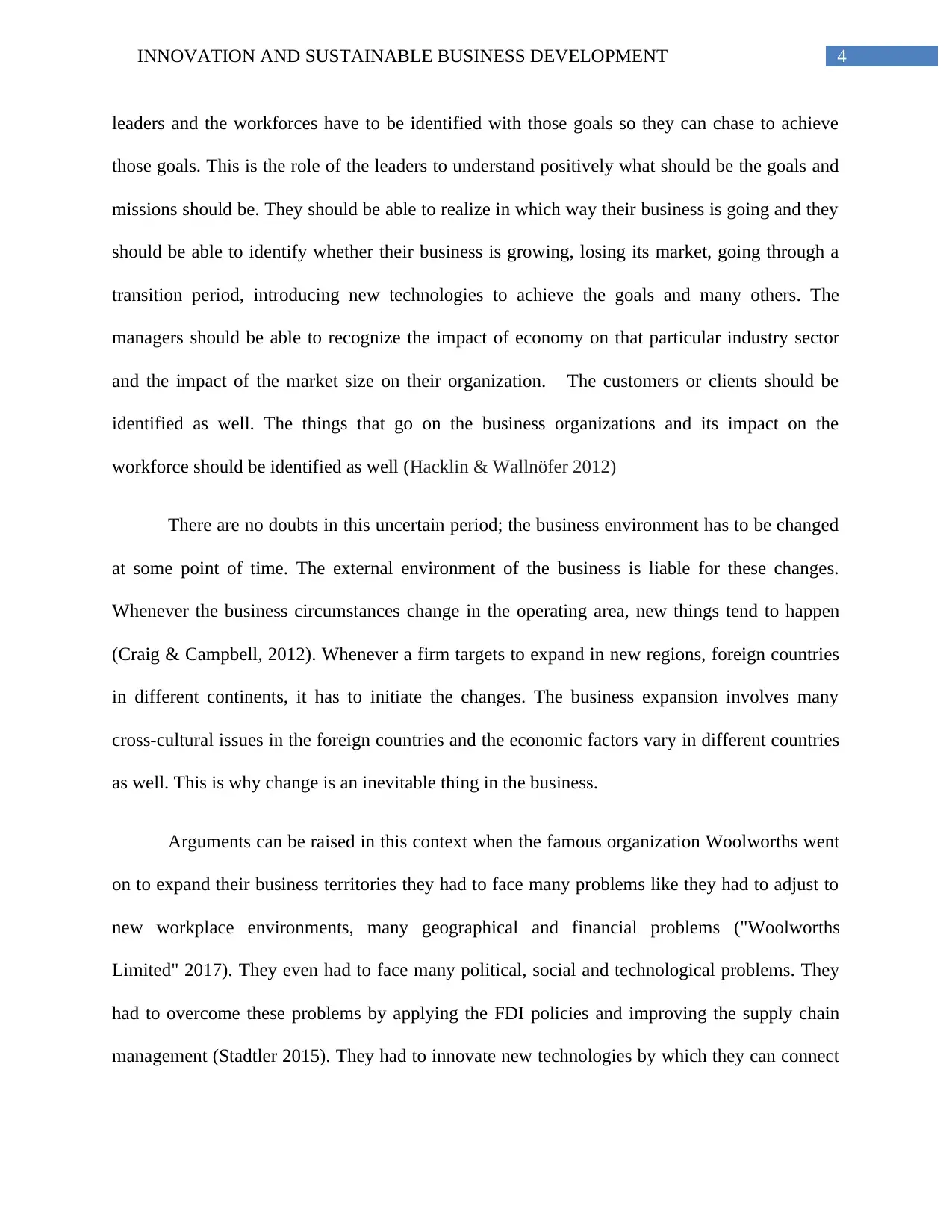
4INNOVATION AND SUSTAINABLE BUSINESS DEVELOPMENT
leaders and the workforces have to be identified with those goals so they can chase to achieve
those goals. This is the role of the leaders to understand positively what should be the goals and
missions should be. They should be able to realize in which way their business is going and they
should be able to identify whether their business is growing, losing its market, going through a
transition period, introducing new technologies to achieve the goals and many others. The
managers should be able to recognize the impact of economy on that particular industry sector
and the impact of the market size on their organization. The customers or clients should be
identified as well. The things that go on the business organizations and its impact on the
workforce should be identified as well (Hacklin & Wallnöfer 2012)
There are no doubts in this uncertain period; the business environment has to be changed
at some point of time. The external environment of the business is liable for these changes.
Whenever the business circumstances change in the operating area, new things tend to happen
(Craig & Campbell, 2012). Whenever a firm targets to expand in new regions, foreign countries
in different continents, it has to initiate the changes. The business expansion involves many
cross-cultural issues in the foreign countries and the economic factors vary in different countries
as well. This is why change is an inevitable thing in the business.
Arguments can be raised in this context when the famous organization Woolworths went
on to expand their business territories they had to face many problems like they had to adjust to
new workplace environments, many geographical and financial problems ("Woolworths
Limited" 2017). They even had to face many political, social and technological problems. They
had to overcome these problems by applying the FDI policies and improving the supply chain
management (Stadtler 2015). They had to innovate new technologies by which they can connect
leaders and the workforces have to be identified with those goals so they can chase to achieve
those goals. This is the role of the leaders to understand positively what should be the goals and
missions should be. They should be able to realize in which way their business is going and they
should be able to identify whether their business is growing, losing its market, going through a
transition period, introducing new technologies to achieve the goals and many others. The
managers should be able to recognize the impact of economy on that particular industry sector
and the impact of the market size on their organization. The customers or clients should be
identified as well. The things that go on the business organizations and its impact on the
workforce should be identified as well (Hacklin & Wallnöfer 2012)
There are no doubts in this uncertain period; the business environment has to be changed
at some point of time. The external environment of the business is liable for these changes.
Whenever the business circumstances change in the operating area, new things tend to happen
(Craig & Campbell, 2012). Whenever a firm targets to expand in new regions, foreign countries
in different continents, it has to initiate the changes. The business expansion involves many
cross-cultural issues in the foreign countries and the economic factors vary in different countries
as well. This is why change is an inevitable thing in the business.
Arguments can be raised in this context when the famous organization Woolworths went
on to expand their business territories they had to face many problems like they had to adjust to
new workplace environments, many geographical and financial problems ("Woolworths
Limited" 2017). They even had to face many political, social and technological problems. They
had to overcome these problems by applying the FDI policies and improving the supply chain
management (Stadtler 2015). They had to innovate new technologies by which they can connect
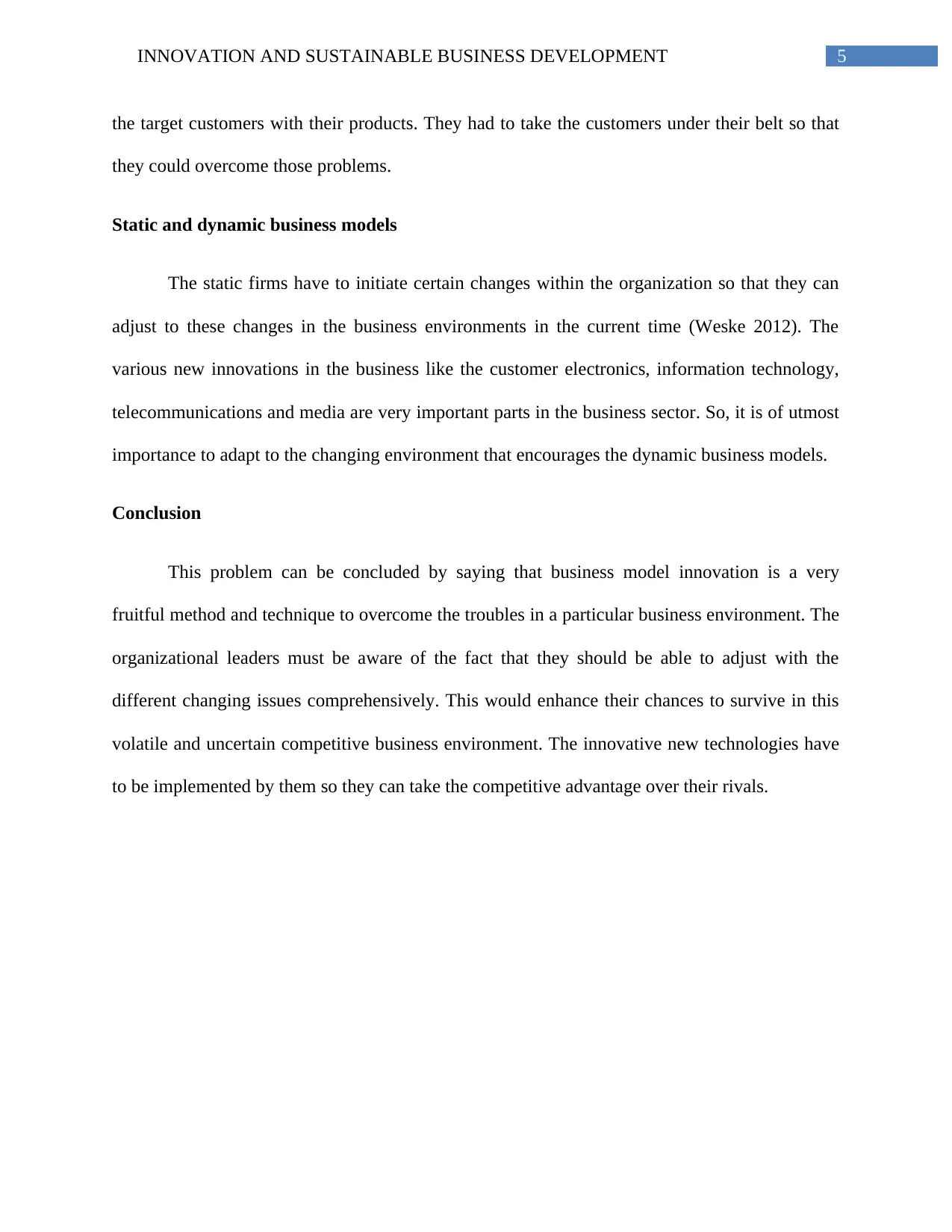
5INNOVATION AND SUSTAINABLE BUSINESS DEVELOPMENT
the target customers with their products. They had to take the customers under their belt so that
they could overcome those problems.
Static and dynamic business models
The static firms have to initiate certain changes within the organization so that they can
adjust to these changes in the business environments in the current time (Weske 2012). The
various new innovations in the business like the customer electronics, information technology,
telecommunications and media are very important parts in the business sector. So, it is of utmost
importance to adapt to the changing environment that encourages the dynamic business models.
Conclusion
This problem can be concluded by saying that business model innovation is a very
fruitful method and technique to overcome the troubles in a particular business environment. The
organizational leaders must be aware of the fact that they should be able to adjust with the
different changing issues comprehensively. This would enhance their chances to survive in this
volatile and uncertain competitive business environment. The innovative new technologies have
to be implemented by them so they can take the competitive advantage over their rivals.
the target customers with their products. They had to take the customers under their belt so that
they could overcome those problems.
Static and dynamic business models
The static firms have to initiate certain changes within the organization so that they can
adjust to these changes in the business environments in the current time (Weske 2012). The
various new innovations in the business like the customer electronics, information technology,
telecommunications and media are very important parts in the business sector. So, it is of utmost
importance to adapt to the changing environment that encourages the dynamic business models.
Conclusion
This problem can be concluded by saying that business model innovation is a very
fruitful method and technique to overcome the troubles in a particular business environment. The
organizational leaders must be aware of the fact that they should be able to adjust with the
different changing issues comprehensively. This would enhance their chances to survive in this
volatile and uncertain competitive business environment. The innovative new technologies have
to be implemented by them so they can take the competitive advantage over their rivals.
⊘ This is a preview!⊘
Do you want full access?
Subscribe today to unlock all pages.

Trusted by 1+ million students worldwide
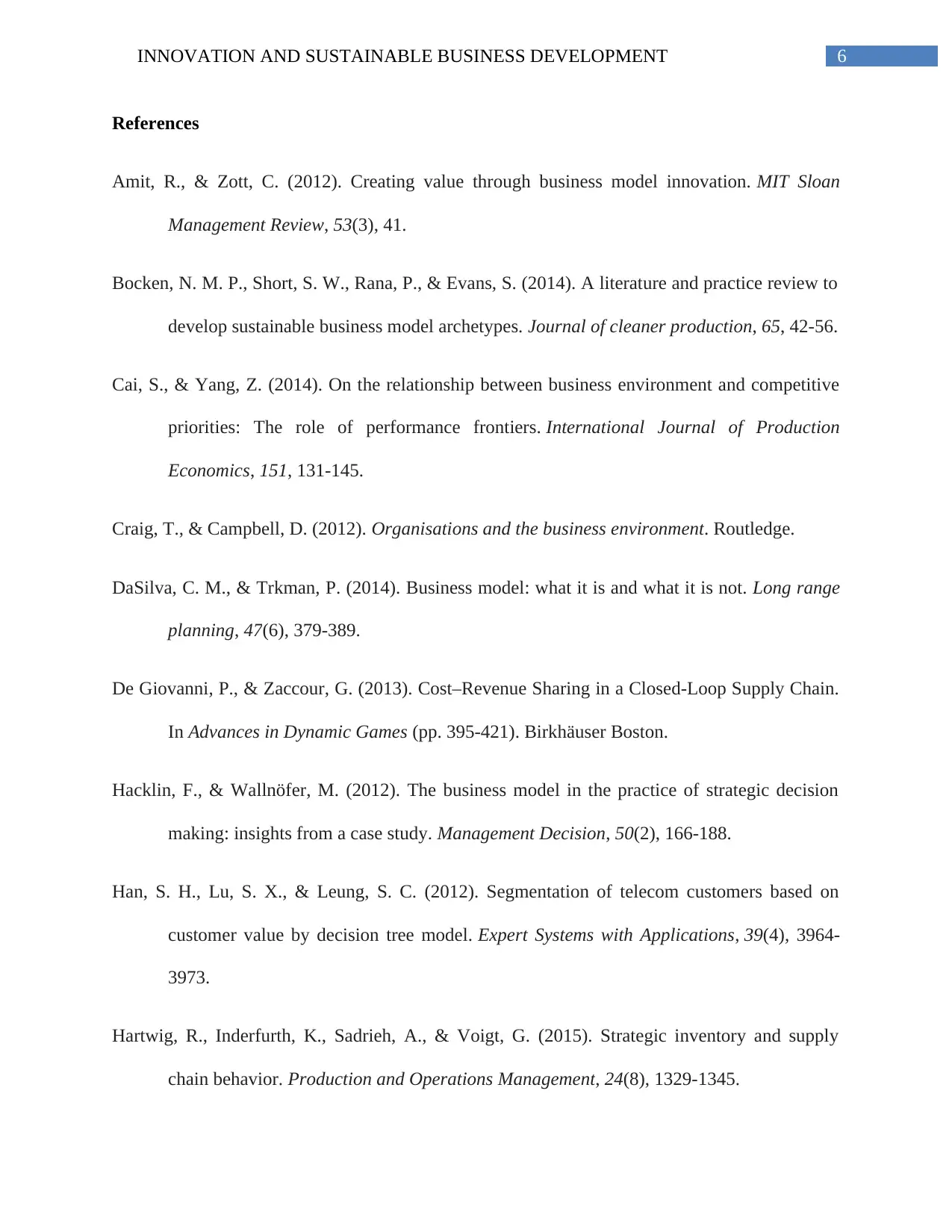
6INNOVATION AND SUSTAINABLE BUSINESS DEVELOPMENT
References
Amit, R., & Zott, C. (2012). Creating value through business model innovation. MIT Sloan
Management Review, 53(3), 41.
Bocken, N. M. P., Short, S. W., Rana, P., & Evans, S. (2014). A literature and practice review to
develop sustainable business model archetypes. Journal of cleaner production, 65, 42-56.
Cai, S., & Yang, Z. (2014). On the relationship between business environment and competitive
priorities: The role of performance frontiers. International Journal of Production
Economics, 151, 131-145.
Craig, T., & Campbell, D. (2012). Organisations and the business environment. Routledge.
DaSilva, C. M., & Trkman, P. (2014). Business model: what it is and what it is not. Long range
planning, 47(6), 379-389.
De Giovanni, P., & Zaccour, G. (2013). Cost–Revenue Sharing in a Closed-Loop Supply Chain.
In Advances in Dynamic Games (pp. 395-421). Birkhäuser Boston.
Hacklin, F., & Wallnöfer, M. (2012). The business model in the practice of strategic decision
making: insights from a case study. Management Decision, 50(2), 166-188.
Han, S. H., Lu, S. X., & Leung, S. C. (2012). Segmentation of telecom customers based on
customer value by decision tree model. Expert Systems with Applications, 39(4), 3964-
3973.
Hartwig, R., Inderfurth, K., Sadrieh, A., & Voigt, G. (2015). Strategic inventory and supply
chain behavior. Production and Operations Management, 24(8), 1329-1345.
References
Amit, R., & Zott, C. (2012). Creating value through business model innovation. MIT Sloan
Management Review, 53(3), 41.
Bocken, N. M. P., Short, S. W., Rana, P., & Evans, S. (2014). A literature and practice review to
develop sustainable business model archetypes. Journal of cleaner production, 65, 42-56.
Cai, S., & Yang, Z. (2014). On the relationship between business environment and competitive
priorities: The role of performance frontiers. International Journal of Production
Economics, 151, 131-145.
Craig, T., & Campbell, D. (2012). Organisations and the business environment. Routledge.
DaSilva, C. M., & Trkman, P. (2014). Business model: what it is and what it is not. Long range
planning, 47(6), 379-389.
De Giovanni, P., & Zaccour, G. (2013). Cost–Revenue Sharing in a Closed-Loop Supply Chain.
In Advances in Dynamic Games (pp. 395-421). Birkhäuser Boston.
Hacklin, F., & Wallnöfer, M. (2012). The business model in the practice of strategic decision
making: insights from a case study. Management Decision, 50(2), 166-188.
Han, S. H., Lu, S. X., & Leung, S. C. (2012). Segmentation of telecom customers based on
customer value by decision tree model. Expert Systems with Applications, 39(4), 3964-
3973.
Hartwig, R., Inderfurth, K., Sadrieh, A., & Voigt, G. (2015). Strategic inventory and supply
chain behavior. Production and Operations Management, 24(8), 1329-1345.
Paraphrase This Document
Need a fresh take? Get an instant paraphrase of this document with our AI Paraphraser
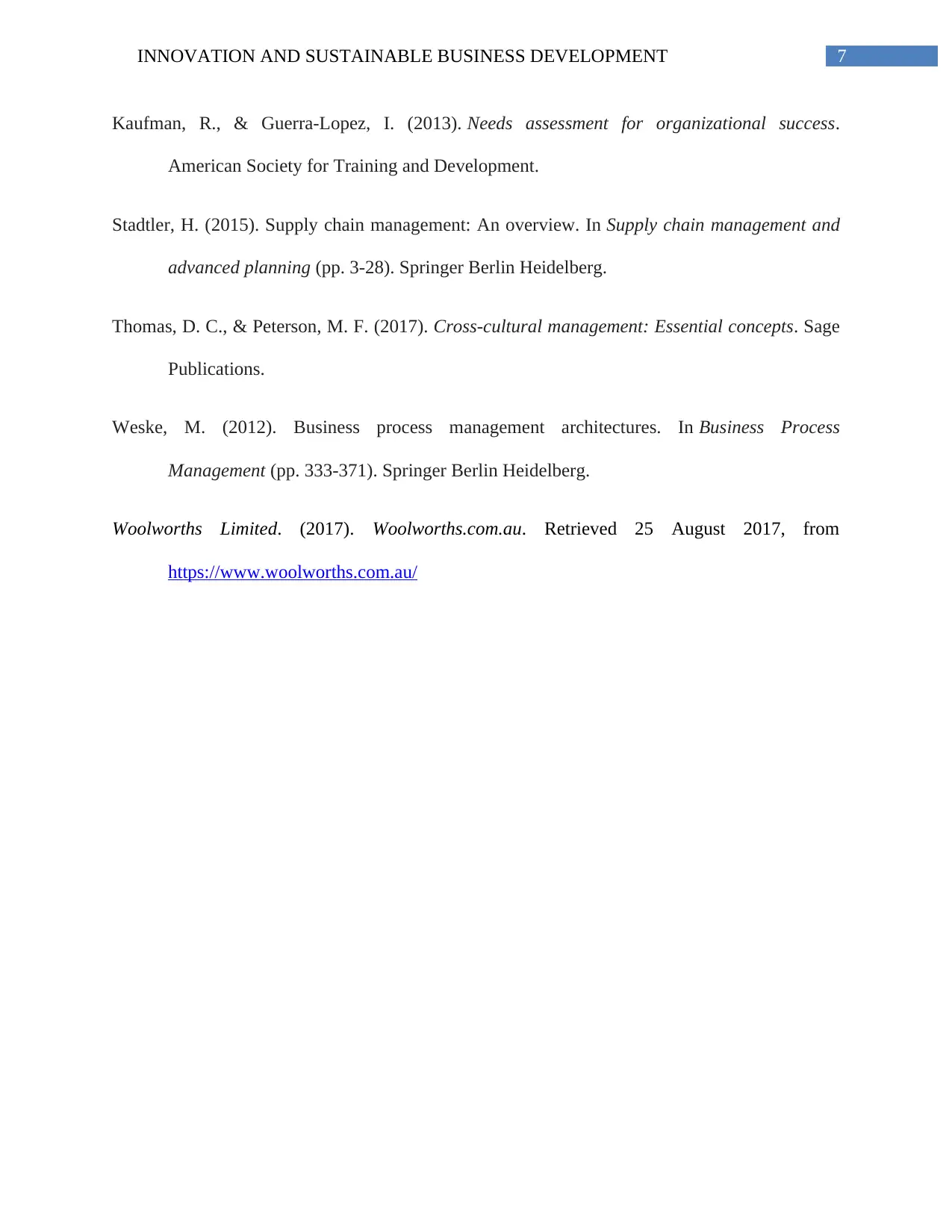
7INNOVATION AND SUSTAINABLE BUSINESS DEVELOPMENT
Kaufman, R., & Guerra-Lopez, I. (2013). Needs assessment for organizational success.
American Society for Training and Development.
Stadtler, H. (2015). Supply chain management: An overview. In Supply chain management and
advanced planning (pp. 3-28). Springer Berlin Heidelberg.
Thomas, D. C., & Peterson, M. F. (2017). Cross-cultural management: Essential concepts. Sage
Publications.
Weske, M. (2012). Business process management architectures. In Business Process
Management (pp. 333-371). Springer Berlin Heidelberg.
Woolworths Limited. (2017). Woolworths.com.au. Retrieved 25 August 2017, from
https://www.woolworths.com.au/
Kaufman, R., & Guerra-Lopez, I. (2013). Needs assessment for organizational success.
American Society for Training and Development.
Stadtler, H. (2015). Supply chain management: An overview. In Supply chain management and
advanced planning (pp. 3-28). Springer Berlin Heidelberg.
Thomas, D. C., & Peterson, M. F. (2017). Cross-cultural management: Essential concepts. Sage
Publications.
Weske, M. (2012). Business process management architectures. In Business Process
Management (pp. 333-371). Springer Berlin Heidelberg.
Woolworths Limited. (2017). Woolworths.com.au. Retrieved 25 August 2017, from
https://www.woolworths.com.au/
1 out of 8
Related Documents
Your All-in-One AI-Powered Toolkit for Academic Success.
+13062052269
info@desklib.com
Available 24*7 on WhatsApp / Email
![[object Object]](/_next/static/media/star-bottom.7253800d.svg)
Unlock your academic potential
Copyright © 2020–2025 A2Z Services. All Rights Reserved. Developed and managed by ZUCOL.





